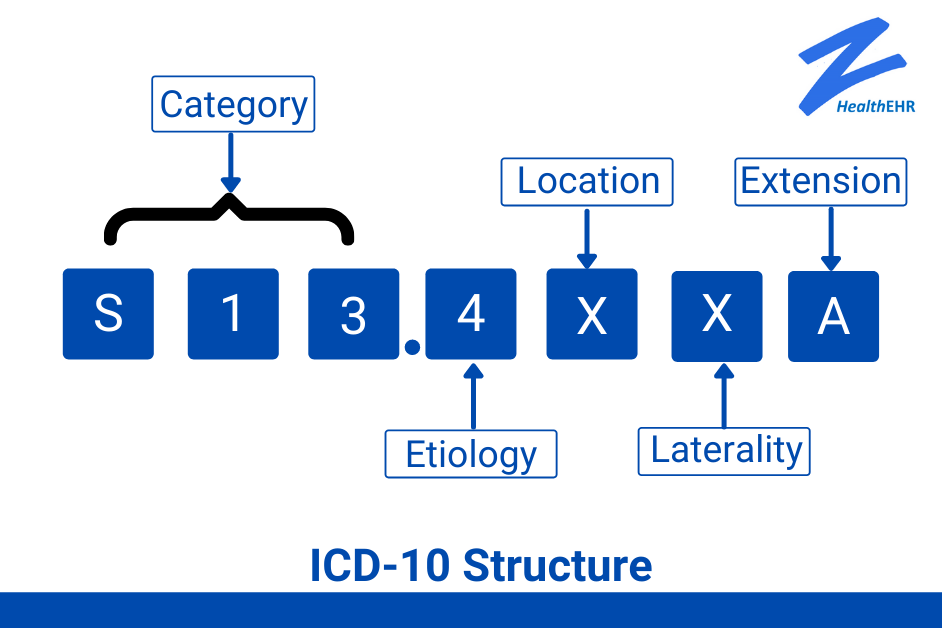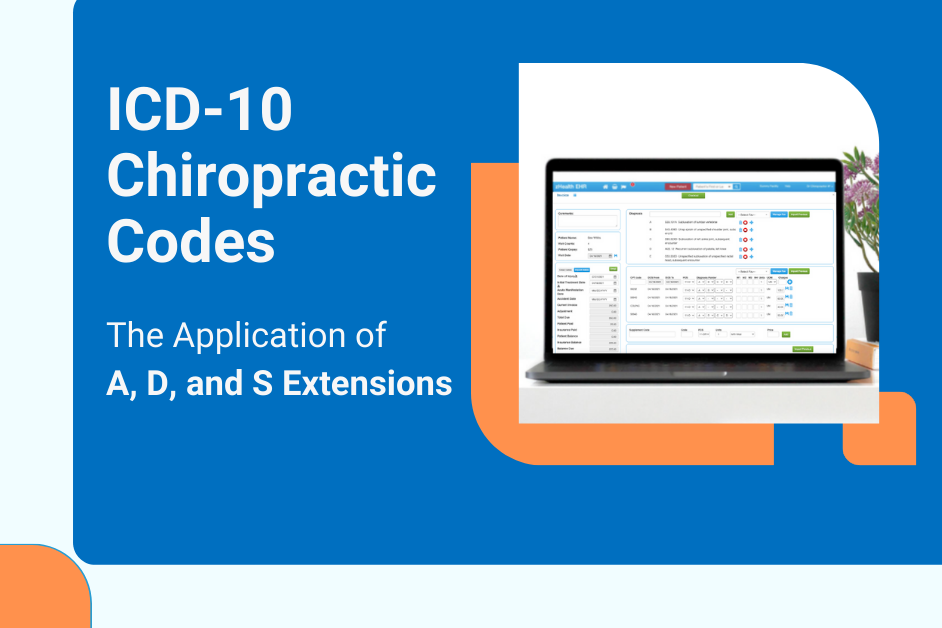The International Classification of Diseases (ICD)-10 code is a seven-character, alphanumeric code that is used by chiropractic practices and healthcare providers to communicate the diagnosis to the patient’s insurance company. This coding system was introduced into US healthcare in the 1980s, but the system has evolved through various editions until it reached ICD-10 on October 1, 2015.
Each year ICD-10 codes for chiropractors and other providers keep changing and increasing in number. So it’s important for chiropractic practices to be aware of any code changes. If you’re using integrated chiropractic EHR and billing software, keeping track of these ICD-10 code changes becomes easy. Chiropractic EHR vendors update the new codes in their software so you don’t have to remember and keep checking code sites for reference. Apart from staying up to date with coding changes, what chiropractors need to know is how to use the code extensions depending on the patient’s diagnosis. Without the correct use of ICD-10 codes, claims will be rejected by insurance companies. In this blog, we have outlined when to use the A, D, and S extensions to ensure you get paid what you deserve.
The Chiropractic Application of A, D, and S Extensions
Each ICD-10 chiropractic code begins with a letter, followed by two numbers. The first digit of an ICD-10 code is always an alpha and the second digit is always numeric. The remaining 5 digits may be a combination of alpha/numeric. The last character is always the extension. All ICD-10 chiropractic codes are followed by a decimal after the third (3rd) character. Take a look at these ICD-10 codes:
| S13.4XXA | Sprain of ligaments of cervical spine, initial encounter |

- The first three characters of ICD-10 define the “category.” The category is the general type of injury or disease. The three category characters are followed by a decimal point and the subcategory.
- The next three characters indicate the anatomic site, severity, or other vital clinical details. These three characters explain the set of causes, or manner of causation of a disease or condition, location, and more.
- According to CMS, it “provides[s] information about the characteristics of the encounter.” The 7th-digit character extender is where things go awry. It is tricky. Let’s talk about how and when to use the 7th-digit extension while coding.
The 7th Character in ICD-10 Chiropractic Codes
What 7th character extensions are commonly used in the chiropractic industry? There are three commonly used extensions in ICD-10 codes. The extensions provide information about the characteristics of the patient encounter.
- A = Initial encounter
- D = Subsequent encounter
- S = Sequela
7th Character “A”
The Initial Encounter “A” extension indicates the phase when the patient is receiving active treatment from the provider for the injury, poisoning, or other consequences of an external cause.
7th Character “D”
The Subsequent Encounter “D” extension indicates an encounter when the patient is receiving routine care during the period of healing or recovery after the active phase of treatment for the injury. In the chiropractic industry, routine care is “maintenance” care. So this routine or maintenance care is the “subsequent” care. Chiropractors provide maintenance care when the active condition/injury is resolved. So when chiropractors provide maintenance care after the active phase of treatment, they need to apply the “D” extension to signify the “subsequent” visit.
7th Character “S”
The”S” (Sequela) extension indicates the complications that arise as a direct result of a condition. When a patient shows late effects of a musculoskeletal injury that manifest themselves after active treatment, the provider can apply the “S” character extender (but with caution).
Important Facts About A, D, and S Extensions
- When coding the 7th character, your biller and coder should not focus on the number of times the patient has visited your practice, but on the type of treatment that the provider is providing.
- The 7th character extension in ICD-10 is not optional. If providers don’t use it when required, it can lead to claim rejection or denial.
- The “A” extension may be assigned on more than one claim.
- When using the seventh character “S”, sequela, it is necessary to use both the injury code that caused the sequela and the code for the sequela itself. For instance, residual pain arising from the cervical spine should be coded in the following manner.
S13.4XXS This indicates this pain is a sequela of a cervical sprain
M54.2 Cervical pain (as a primary symptom)
Cervical S13.4XXS This indicates this pain is a sequela of a cervical sprain
- When a patient is undergoing active treatment, the A extension indicates “initial encounter.” This does not mean the same thing as “initial visit.”
- The “A” extension refers to the patient’s initial encounter with the injury, and not with the provider. So the “A” extension would be used for all visits, even if it’s 5, 10, or 15 visits, when the patient is under active treatment (that is, as long as the patient continues to progress).
- Use the “D” extension to code encounters when the patient is receiving routine or maintenance care. For instance, a patient with shoulder pain returns to the office to get his or her joint stability re-evaluated to ensure that the injury is healing properly. In this case, the seventh character “D” would be assigned.
- The “A” initial encounter and “D” subsequent encounter have nothing to do with the established or new patient visits mentioned in CPT codes.
- If ICD-10 codes have fewer than 6 characters, providers need to use the dummy placeholder denoted by “X”. The “X” placeholder needs to be added in all the empty slots between the first and the 7th character extension. This placeholder is not case-sensitive and is not optional.
Conclusion
We hope this information proves useful while coding the common chiropractic ICD 10 codes with extensions. If you have any billing or coding questions, we are here to help you. Our zHealth billing software is updated with the new ICD-10 coding changes and makes it easier for you to code correctly and seamlessly. Request a free demo. If you want expert billers and coders to manage your chiropractic medical billing, contact our managed billing team now. By hiring our managed billing services, your practice can benefit by avoiding ICD-10 and CPT coding complications and also reduce costs and increasing efficiency. Call us at +1 (800) 939-0319.
You May like to Read:
5 Things to Know About Chiropractic ICD-10 Updates For Fiscal Year
ICD-10 Chiropractic Codes: Avoid Claim Denials Pertaining to Excludes Notes


